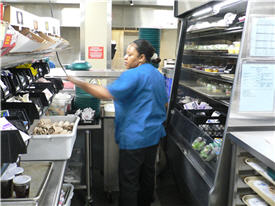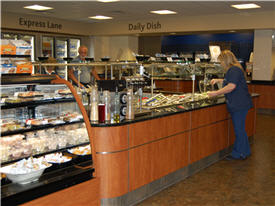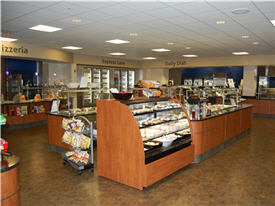A 30,000-square-foot renovation in over a two-year period produced a scatter-system cafe and full-service bakery, kitchen with a pod-style tray-assembly system, cold-food production areas and a receiving dock exclusively for foodservice.
The foodservice operation at the 650-bed St. Joseph's Hospital in Tampa, Fla., was insufficient. The 19-year-old infrastructure plumbing problems and refrigeration breakdowns, foodservice equipment was worn, and an efficient tray delivery system was needed to boost patient satisfaction scores. In addition, the dining location's ambience seemed "institutional" to staff and visitors.
"The physical condition of the facilities and a detailed, positive economic plan convinced the administration that we needed to renovate and actually replace the entire facility," says John Vidmar, St. Joseph's director of food and nutrition services. "Originally we anticipated building the department in a new location. Unfortunately, due to a lack of additional space on our campus, we had to build a new department in the existing location. As a result, we needed many phases of construction that spanned two years. We built a tunnel for our largest phase of construction through the middle of the foodservice department so we could get food from the kitchen delivered to our patients and the cafeteria."
The project addressed receiving and storage, production, patient-tray assembly and delivery and dish and cart washing, as well as foodservice administrative offices and a doctors' dining room and lounge. Season's Café, a dining room and servery open to the public, needed an overhaul. Approval for the renovation came with a tight timeframe for completion.
"The biggest challenge was infection control," Vidmar says. "We had to prevent construction dust from entering into the active food operation." A temporary serving line with a few steamtable items, prepackaged sandwiches and wraps and fountain beverages was set up in a former clinical area, while vendor-provided food was made available in an outdoor courtyard.

During construction, patient-tray assembly pods, which are work stations containing materials needed for preparing trays, were set up in a back-of-house area.
Foodservice deliveries have a designated receiving dock, which features easily accessible dry storage, walk-in refrigeration and freezers. Electric bi-parting doors in coolers and freezers accommodate the movement of pallets and forklift trucks.
Adjacent to the ambient, non-food storage area and cook chill system, an issue refrigerator holds food for the next day's production; a bulk refrigerator and freezer.
Nearby, the bakery storage area fronts onto the cafeteria so customers can watch the action.

"Product flows logically," says project foodservice consultant Paul Hysen, president of The Hysen Group. "Production backs up against patient tray assembly pods. Returning patient food delivery carts arrive directly to the sanitation areas, are cleaned and parked next to the pod assembly areas. The staff's travel paths are short and straightforward."
The cold-food prep room is equipped with an ice maker and walk-in blast chiller. Blenders, a slicer, food processor, mixer and mobile tables support preparation of vegetables, salad dressings and sandwiches.
In the hot-food production area a cook/hold oven, two 80-gallon kettles, 60-gallon kettle, braising pan, fryer with filter system, broiler, grate-top range, revolving-rack oven and convection steamer turn out soups, vegetables, rice and entrées such as roasts, burgers, pancakes and omelets.
Tray-assembly pods are located on the other side of Season's Café.
Three pods with a dish dispenser, open-front refrigerator for sheet pans, and hot-food counter operation work together. For patient orders, attendants place entrée plates on an induction-heated base; beverages and other items are added by nutrition representatives before the transport cart leaves the kitchen.
"With the spoken menu, which complements the pod system, a patient-nutrition representative sees each patient perhaps up to eight times a day," Hysen says..
"The pod system results in high patient satisfaction and labor efficiency," says Don Brown, Hysen Group senior vice president. "Fewer employees are needed for this type of system than with a traditional trayline or room-service concept."
The switch from trayline to pod system reduced the tray-assembly time needed for 450 patients to 90 minutes from 120 minutes, with built-in staff incentives.
"We post the times each attendant requires to plate the food items," Vidmar says. "At monthly meetings, we recognize those who did the best and tie the recognition in with [employees who handle the bed-service operation]." Teams with the highest scores receive meal certificates, pizza parties and ice-cream socials.
Season's Café's old L configuration was replaced with a scatter servery design, with positive results: Post-construction annual revenues climbed from $3 million to more than $4 million, with a 20 percent increase in customer participation. The cafe serves nearly half of the hospital's 4,500 employees, about 3,500 transactions per day.
Only the columns remain from the original structure in the servery, which overlooks a landscaped patio. "The servery and dining room were designed so they wouldn't be identified with a specific period" and soon look outdated, Hysen says. Materials, selected for durability and ease of cleaning, include manufactured stone, wood veneer counter fronts and mostly blue and white ceramic tile.
The servery's multiple stations minimize customer wait time. Sight lines were carefully considered so that customers get an overview of the options as they enter, says Hysen.
A combination of incandescent, fluorescent and LED lighting creates a warm ambiance. Comfortable seating of mostly tables and chairs with vinyl seat cushions and wide aisles contribute to a relaxed dining experience.
Design highlights include a standalone condiment station that pulls traffic through the cashier area, and the in-house bakery where items are displayed for customers.
The bakery uses a proofer, rotating-rack oven, transport carts and ambient- and refrigerated-display cases. Customers select from a variety of cakes, pies, cookies and breads. A toaster for bagels and bread is set on a counter for customer use.
The cafe's menu offers plenty of choices for dine-in and to-go customers.
The Sandwich Shop deli station offers sandwiches to go, warmed in panini grills or convection/microwave ovens by staff.
The adjacent pizza station's stone hearth oven is an attention-getter. Customers watch staff prepare pizzas using house-made dough. The oven also bakes calzones and breadsticks; quesadillas are in a test phase.
A few steps away, a self-serve station offers pasta, chicken fingers, French fries and burgers. The items are held on electric heated ceramic counters underneath heat lamps.
Express Lane, another grab-and-go station, displays sandwiches, salads and other packaged products and beverages in a glass-door walk-in refrigerator. "[The walk-in has] high-capacity shelving like you'd find in c-store cases," Hysen says. "Staff can restock from the kitchen so they don't have to walk out in front of customers and disrupt service," he adds.


In the Rotisserie area, a glass-doored, eight-spit rotisserie oven roasts chicken and other meats.. "We're now selling about 12 home-meal replacements with whole chickens and sides of vegetables, potatoes and mac and cheese each day, as well as 20 whole pizzas to go," Vidmar says. "I expect this demand to increase."
The attached chef's-specials counter, Daily Dish, uses induction ranges to prepare Mexican and Asian cuisine and American barbecue. In the spring, staff celebrate a spring strawberry festival here with chocolate-dipped strawberry desserts.

A centrally-located salad bar contains 14 feet of cold wells. hot-soup wells are at one end; a refrigerated sushi case on the other. Condiments are dispensed from a bag-in-box system beneath the counter.
Stations offering hot and cold beverages and gelato are situated near the cashier area. "Beverage dispensers don't stick up high into the air, so they don't block people's view," Brown says. "Also, ice production and storage is beneath the counters."
Unlike many new hospital cafes, St. Joseph's has a separate physicians' dining area, a smaller version of Season's Café that includes a lounge equipped with dictation stations.
The servery's hours are 6:30 a.m. until 2 a.m., the rotisserie and chef's stations are shut down at 4 p.m. Pizza and deli stations and freshly stocked salad bar remain open until closing.
Vidmar, his staff, Hysen and Brown agree that the renovation has resulted in an operation that is pleasant, durable and efficient. "We worked with a very conservative budget--$300 per square foot, including equipment," says Hysen. In today's cost-conscious environment, meeting all aesthetic, functional and budget goals is worth noting.





